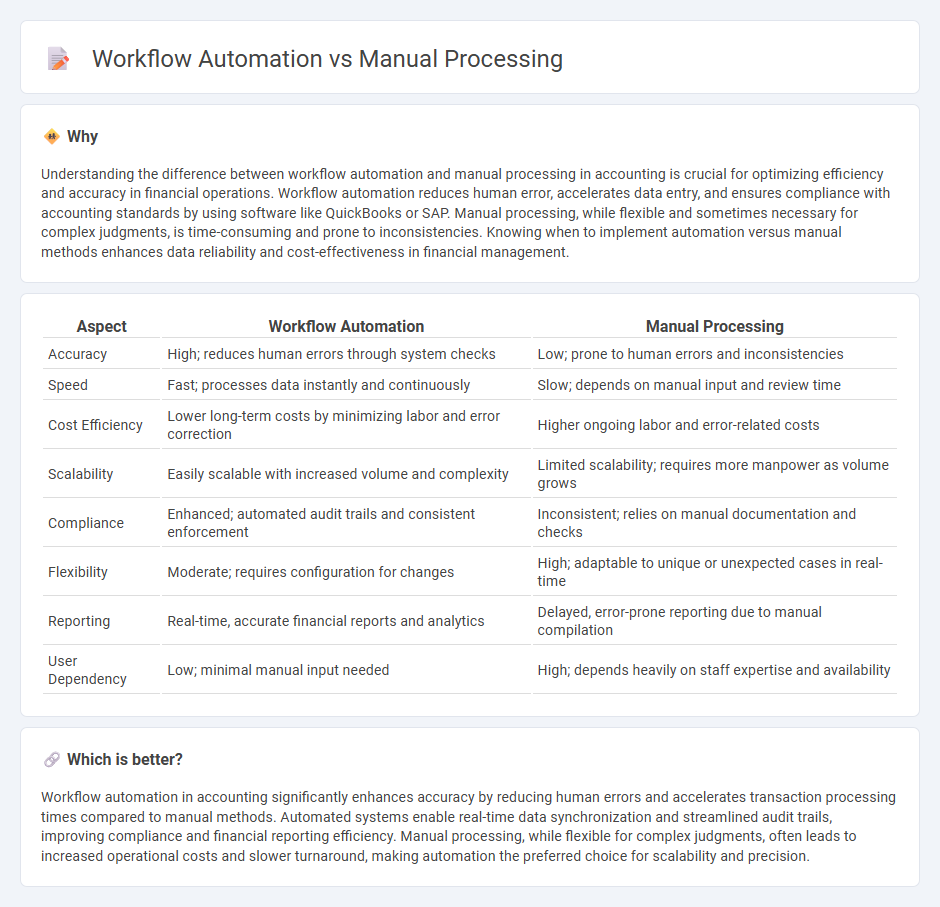
Workflow automation in accounting streamlines repetitive tasks such as invoicing, expense tracking, and financial reporting, significantly reducing errors and processing time compared to manual methods. Manual processing often involves extensive data entry and reconciliation, increasing the risk of discrepancies and delaying critical financial insights. Discover how integrating workflow automation can transform your accounting efficiency by exploring detailed comparisons and benefits.
Why it is important
Understanding the difference between workflow automation and manual processing in accounting is crucial for optimizing efficiency and accuracy in financial operations. Workflow automation reduces human error, accelerates data entry, and ensures compliance with accounting standards by using software like QuickBooks or SAP. Manual processing, while flexible and sometimes necessary for complex judgments, is time-consuming and prone to inconsistencies. Knowing when to implement automation versus manual methods enhances data reliability and cost-effectiveness in financial management.
Comparison Table
| Aspect | Workflow Automation | Manual Processing |
|---|---|---|
| Accuracy | High; reduces human errors through system checks | Low; prone to human errors and inconsistencies |
| Speed | Fast; processes data instantly and continuously | Slow; depends on manual input and review time |
| Cost Efficiency | Lower long-term costs by minimizing labor and error correction | Higher ongoing labor and error-related costs |
| Scalability | Easily scalable with increased volume and complexity | Limited scalability; requires more manpower as volume grows |
| Compliance | Enhanced; automated audit trails and consistent enforcement | Inconsistent; relies on manual documentation and checks |
| Flexibility | Moderate; requires configuration for changes | High; adaptable to unique or unexpected cases in real-time |
| Reporting | Real-time, accurate financial reports and analytics | Delayed, error-prone reporting due to manual compilation |
| User Dependency | Low; minimal manual input needed | High; depends heavily on staff expertise and availability |
Which is better?
Workflow automation in accounting significantly enhances accuracy by reducing human errors and accelerates transaction processing times compared to manual methods. Automated systems enable real-time data synchronization and streamlined audit trails, improving compliance and financial reporting efficiency. Manual processing, while flexible for complex judgments, often leads to increased operational costs and slower turnaround, making automation the preferred choice for scalability and precision.
Connection
Workflow automation in accounting streamlines repetitive tasks such as data entry, invoicing, and reconciliation, reducing the need for manual processing and minimizing human errors. Manual processing remains essential for tasks requiring judgment, complex decision-making, and exceptions that automation cannot handle effectively. Integrating workflow automation with manual processing enhances overall efficiency by combining the speed of automated systems with the accuracy and insight of human oversight.
Key Terms
Data Entry
Manual data entry involves human input, which increases the risk of errors and consumes significant time and resources. Workflow automation streamlines data entry by using software to capture, validate, and store information rapidly and accurately, improving efficiency and reducing operational costs. Explore the benefits of automating data entry processes to enhance productivity and accuracy in your organization.
Approval Routing
Manual approval routing relies heavily on human intervention, increasing the risk of errors and delays in document processing. Workflow automation streamlines approval paths by automatically directing documents to the right stakeholders based on predefined rules, boosting efficiency and compliance. Discover how switching to workflow automation can enhance accuracy and accelerate approval cycles.
Process Efficiency
Manual processing often leads to increased errors and longer cycle times due to repetitive human intervention, lowering overall process efficiency. Workflow automation streamlines task execution by integrating systems and reducing manual input, resulting in faster turnaround and higher accuracy. Explore how implementing workflow automation can significantly enhance your operational efficiency.
Source and External Links
Automate Manual Process to manage your Business - Cflow - Manual processing involves human effort to perform tasks, which can be simple or complex, and automation of such manual processes requires clear goal definition and identifying the target subprocesses for effective implementation.
Manual Processing Definition | Law Insider - Manual processing is described as the manual authorization of transactions or payments without electronic confirmation, typically used when technical malfunctions prevent automated methods.
Manual Process vs Automated Process: A Comparison Guide - Manual processes require human involvement for tasks like data entry and verification, are more time-consuming and error-prone compared to automated processes where machines perform tasks to enhance efficiency.
 dowidth.com
dowidth.com